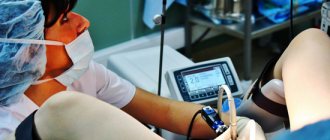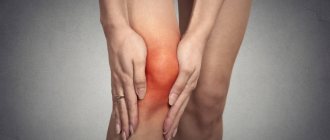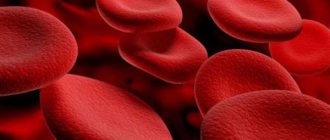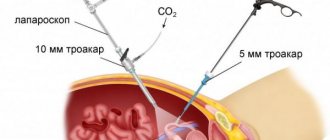Rehabilitation after laparoscopy
Recovery after surgery takes from 2 to 4 weeks, depending on the severity of the operation and the development of any complications. For 2-3 hours after the operation, the woman recovers from general anesthesia - during this time she may feel weakness, nausea, and dizziness. All recommendations of the operating surgeon should be strictly followed.
Also, on the first day after laparoscopy, a woman may feel pain in the lower abdomen - in most cases, these painful sensations are mild. This may be the result of both the surgical intervention itself and the carbon dioxide that remains inside the abdominal cavity and begins to be slowly absorbed by the body. If the pain is very severe, you should immediately inform your doctor - he will prescribe painkillers.
When can you get up after laparoscopic surgery? Treatment with the laparoscopic method has many advantages, including a shorter postoperative period, which, unlike classical surgical treatment, lasts only a few weeks. Already 3-4 hours after the operation, the patient is allowed to get up and walk around the room a little. Walking is not only allowed, but also strongly recommended - this is necessary in order to normalize blood circulation after laparoscopy, as well as prevent the development of thrombophlebitis and adhesions. Of course, you shouldn’t be too zealous with walking - all movements should be as smooth and careful as possible.
Many women who have undergone laparoscopic treatment are concerned with the question: how many days after surgery can you drink and eat? It is not recommended to eat on the first day after surgical treatment - the body must “rest” after surgery. You can drink already on the first day after laparoscopy - it is best to drink non-carbonated mineral water, fruit compote or fruit drink, weak tea, jelly. You need to drink in small sips, trying not to strain your abdominal muscles.
When to Seek Urgent Help
As after any surgical procedure, laparoscopy does not exclude the possibility of complications. Although here they are extremely rare.
You should be aware of the manifestations of complications of surgical intervention in order to urgently call an ambulance or seek advice from your doctor.
Such manifestations of severe postoperative conditions include:
- Loss of consciousness (fainting);
- Acute lack of oxygen, respiratory failure;
- Pain that does not go away after taking pain medication;
- Violation of the integrity of the suture and opening of the surgical wound;
- Discharge of bright red blood that has soaked the entire surgical dressing;
- Increased pain, swelling, warmth, or redness in the surgical area;
- The appearance of red stripes on the skin coming from the incision area;
- Leakage of pus from the incision wound;
- Fever;
- Chest pain;
- Headache, dizziness;
- Severe abdominal pain, accompanied by frequent loose stools.
If you suspect thrombosis, you urgently need to go to the hospital to prevent thromboembolism - the detachment of a blood clot and its movement towards the lung and heart.
Possible negative manifestations
Complications after laparoscopy are a rare phenomenon, but they do occur.
The occurrence of complications is due to three main reasons: an unexpected reaction of the patient to anesthesia or the introduction of carbon dioxide, the patient’s failure to comply with medical recommendations during the recovery period, a poorly performed operation (medical inattention, errors)
Complications of anesthesia
Before laparoscopy, the patient undergoes an examination, which helps the anesthesiologist to choose the best anesthesia (drug and dosage) that is suitable for a particular person, taking into account his individual characteristics. An inadequate reaction rarely occurs; the most extreme form of manifestation can be an acute allergic reaction - anaphylactic shock. Failure of bronchopulmonary and cardiac activity can occur under the influence of carbon dioxide. The complication is rare and depends on individual characteristics (chronic heart and bronchial diseases), or non-standard gas administration.
Pathological manifestations due to the fault of the patient
Every doctor must give recommendations after laparoscopy, which the patient must follow during the rehabilitation period. There are dietary restrictions, as well as prohibitions on serious physical activity after surgery to remove the affected organ or part of it. If the recommendations are not followed, suppuration and infection of the sutures, bleeding, and inflammatory processes in the gallbladder, uterus, urinary system and other organs of the abdominal cavity and pelvis occur.
Complications depending on medical personnel
An improperly performed operation or equipment malfunction can lead to certain negative consequences. Patients with chronic cardiac disorders, atherosclerosis, and varicose veins are given blood thinning medications before surgery. If the doctor ignores this manipulation, there is a danger of blood clots forming. If the laparoscope malfunctions or the doctor is not qualified, there is a risk of injury to adjacent organs and vessels. For example, when removing stones from the gallbladder, an inexperienced doctor can damage its walls.
Of particular danger is the primary puncture made by the Veress needle when the laparoscope is not yet functioning. Manipulation blindly may lead to bleeding. The occurrence of adhesions is most typical after resection of appendicitis. To stop standard bleeding after excision of a part of an organ, the coagulation method (cauterization with electric current) is used. Incorrect use of the method causes severe burns to internal organs. By cutting off the affected area, the doctor can burn an adjacent organ, which will lead to the development of necrosis (death) of the organ tissue.
Violation of sterility by medical personnel causes infection of the incision, and as a consequence, the occurrence of a purulent-inflammatory process in the suture area. Incorrect removal of an organ affected by cancer can cause skin cancer when it is removed from the abdominal cavity. The occurrence of postoperative hernias is caused by improper suturing of the troacal openings after the removal of large fragments of organs. This complication may not manifest itself immediately after laparoscopy, but after several weeks or months.
Errors during gallbladder resection operations lead to disruption of the choleretic process, which can result in serious liver diseases. Pregnancy during surgery requires special attention. If the doctor acts carelessly, there is a risk of miscarriage (miscarriage) or the development of oxygen deficiency (hypoxia) in the fetus, as a reaction to the introduction of carbon dioxide. If unexpected situations arise during laparoscopy, the doctor should proceed to open laparotomy to avoid more serious negative consequences.
The listed complications can be prevented if you carefully choose a clinic for the operation. In addition, the patient must strictly follow all the doctor’s advice during the rehabilitation period.
Pathological discharge after laparoscopy
Heavy bleeding, especially if it lasts for a long time, should be considered dangerous. In this case, you should immediately consult a doctor, because the above may indicate bleeding.
Any discharge that differs from normal indicates the need for consultation and subsequent treatment of existing problems!
Brown discharge after laparoscopy should be considered normal, which indicates residual bleeding. If the color changes to yellow-green, and there is an unpleasant and pungent odor, these are symptoms indicating an infection.
The white color of the discharge, as well as the accompanying burning sensation, indicate thrush.
In the last two cases, emergency medical care is not required. However, it is necessary to consult a doctor as soon as possible. Lack of proper treatment can lead to complications in a weakened body.
Bloody-mucous discharge often lasts for several weeks. If no pus appears and the smell and consistency do not change, then there is no need to worry. Otherwise, the woman should consult a doctor. The specialist will prescribe tests for the patient to identify the cause.
It may also be that after the operation your periods never come. In this case, how long should it take until sexual function is completely restored? In each case it is different, because it depends on the individual characteristics of the body of a particular patient. If the ovarian tissue was not affected during the operation, the cycle will be restored within 2-3 months. Patients in this case note that menstruation lasted longer than usual and was more abundant.
Cycle disruption after laparoscopy may be due to several aspects
Do not forget that after treatment of an ectopic pregnancy, there may be no discharge, as well as menstruation, for a long period. You should always remember that laparoscopy is an intervention in the normal functioning of the body, which can disrupt normal processes. Any disruption of the menstrual cycle is a signal from the body to seek advice from a specialist.
It is generally accepted that laparoscopy is a practically safe operation and that it will not be followed by serious complications. But like any other surgical technique, it carries health risks. In addition to pathological discharge and cycle disorders, loss of appetite, urinary incontinence, and injuries to internal organs are possible.
To avoid these unpleasant symptoms, the patient must follow all the necessary recommendations of specialists, and also carefully consider the choice of the clinic and the doctor who will perform the operation. Compliance with the rules of the recovery period will allow a woman to quickly get back in shape and return to an active lifestyle without serious health consequences.
Sex
For at least a month, this period is worth abstaining from sex after laparoscopy. Doctors recommend rest and a smooth start to sexual activity after surgery.
This period of calm is necessary for the body so that recently operated and disturbed internal organs recover and begin to function normally.
The body is not yet fully strengthened and the abdominal organs that have suffered from this kind of intervention will not be very happy about passionate and violent sex. It is better to give preference to the least difficult poses, which will minimize the physical stress on the abdominal cavity.
Recovery after surgery usually requires hormonal medications, they are the most suitable contraceptives for preventing pregnancy for at least 3-4 months; it is recommended to take this pause after laparoscopy before planning offspring.
When can you walk after laparoscopy?
It is impossible to give a definite answer to this question. This is due to different volumes of laparoscopic surgery and the general condition of individual patients.
In the case of a satisfactory condition of young operated patients without concomitant pathology and minor interventions, then by the evening such patients can freely walk independently around the territory of the department.
USEFUL INFORMATION: Is it true that children born after IVF are infertile?
This is possible if the operation was performed in the morning. It is highly not recommended to leave the surgical hospital due to the possibility of developing conditions that may require medical attention.
Patients who have undergone major operations or have severe concomitant pathologies are rarely interested in the question of how long after laparoscopy
They can walk because they spend 24 hours in the intensive care unit.
This is necessary for careful monitoring of their condition and quick correction if necessary.
Under these conditions, it is allowed to sit them down with back support in the evening. It's not worth getting up yet. The next day, such patients are transferred to a surgical hospital.
In this case, they can already get out of bed and walk under the supervision of relatives or medical personnel, having first put on a postoperative bandage on the stomach.
This will prevent postoperative sutures from failing. After two or three days, absolutely all patients can walk freely.
When and how much can you eat after laparoscopy?
Another important question that is asked by the vast majority of those undergoing surgery. Again, the answer is not clear cut. Although there are general rules. First of all, this is the very fact of the presence of appetite, which indicates the patient’s recovery.
Its appearance is the main criterion for allowing food intake. By the evening, provided that a small surgical intervention is performed in the morning, all patients are allowed to drink a cup of kefir, sweet tea, or eat a bowl of dietary soup.
If you have no appetite, then you shouldn’t force yourself. One day without food will not cause harm to the body, but an additional load of food in a stressful situation can lead to the development of vomiting.
The approach to severe patients is a little different. Here it is necessary to be guided by the state of intestinal peristaltic activity. Its presence is indicated by the appearance of rumbling and the passage of gases.
This usually happens on the 3rd day. Until this time, you can only take still water and light sweet tea in small sips. After 3 days, or the appearance of intestinal peristalsis, the tactics are the same as in the case of minor operations.
By day 4, the nutrition of absolutely all sick patients is expanded within the framework of dietary table No. 5. Violating this rule is strictly prohibited, especially in the early postoperative period.
How long after laparoscopy can you do physical exercise and work?
There is only one approach to solving this issue. This is the earliest possible activation within reason. This means that performing the exercises included in the section of physical therapy is not only possible, but necessary every day.
They involve moving the limbs without lifting weights or straining the anterior abdominal wall. This regime should be followed for a month. After this period, you can begin normal life. But a gentle regimen should be followed for 3 months. This will prevent the development of postoperative ventral hernias.
The onset of a long-awaited pregnancy does not always go smoothly. Due to the presence of gynecological diseases, a woman may remain infertile. In order to increase the chances of conception, doctors suggest that she undergo laparoscopic surgery if indicated. According to research results, pregnancy after laparoscopy occurs in 85% of cases within a year. In the first 5 months, conception occurs in 30% of operated women.
Laparoscopy differs from traditional surgery in that it is minimally invasive and highly effective.
The essence of the procedure is to make 3 small incisions: a laparoscope (camera with a lamp) is inserted into the peri-umbilical area, and instruments for the operation are inserted through the other 2 incisions. To improve visualization, carbon dioxide is supplied to the abdominal cavity, and the image is transmitted to the monitor.
Indications for laparoscopic intervention include:
- ovarian cysts;
- obstruction of the fallopian tubes;
- adhesions in the fallopian tubes and abdominal cavity;
In this case, laparoscopy can be:
- diagnostic – to clarify or make a diagnosis;
- therapeutic - to remove affected structures.
What can you take and why?
Surgery is only one stage of therapy. Therefore, drug treatment is indicated after laparoscopy. Usually prescribed:
- Broad-spectrum antibiotics. Necessary to prevent an infectious-inflammatory process.
- Anti-inflammatory, enzymatic and wound healing medications. They are needed to prevent scars, adhesions and infiltration - a painful compaction that forms at the site of surgery. For this purpose, after laparoscopy, the ointments most often prescribed are Levomekol, Almag-1, Wobenzym, Kontraktubeks, Lidaza.
- Immunomodulatory drugs - “Immunal”, “Imudon”, “Likopid”, “Tactivin”.
- Hormonal drugs. Indicated to normalize hormonal levels if laparoscopy was performed in women due to gynecological diseases - adnexitis (inflammation of the uterine appendages), endometriosis (abnormal proliferation of cells in the inner layer of the uterus), hydrosalpinx (obstruction of the fallopian tubes), . Longidaza, Clostilbegit, Duphaston, Zoladex, Visanne are prescribed in the form of suppositories, injections for injections, and less often - tablets and oral contraceptives. You need to drink OK after laparoscopy for six months.
- Vitamin complexes. Recommended for general support of the body.
- Painkillers. "Ketonal", "Nurofen", "Diclofenac", "Tramadol" and others. Prescribed for severe pain.
- Products based on simethicone. Needed to eliminate gas formation in the intestines and bloating. The most commonly prescribed drugs are Espumisan, Pepfiz, Meteospasmil, Disflatil, Simikol.
Also, after laparoscopy, you can take drugs that reduce blood clotting and prevent the formation of blood clots - Escusan, Aescin. They are necessary to prevent thrombosis.
What could be the consequences?
As an intervention of any kind, even diagnostic laparoscopy, after which complications are unlikely, does not exclude the occurrence of unpleasant consequences. The duration of the postoperative period is approximately 10 days, but during the day the patient is recommended to remain in bed for a safe recovery from anesthesia. The likelihood of temporary consequences of a diagnostic or therapeutic procedure should also be taken into account.
- The development of pain at the incision sites is considered a completely normal symptom, even if the sensation intensifies with each movement. Such pain can be relieved with painkillers prescribed by your doctor.
- If after gynecological laparoscopy pain appears in the lower abdomen, where the uterus and ovaries are located, additional rest will help to cope with it. If the sensations cannot be tolerated, this may indicate postoperative complications; you should notify your doctor as soon as possible.
- After laparoscopy, as after any intervention in the abdominal cavity, the threat of bloating in the first few days after the procedure is real. To eliminate unpleasant symptoms, on the advice of a doctor, take appropriate medications.
- Symptoms of mild weakness with nausea and lack of appetite usually go away on their own after three days. There is no need to treat them, as well as the appearance of frequent urge to urinate.
- Healing of incisions held together with sutures after the procedure is usually not accompanied by any particular complications. After a maximum of two weeks, the sutures are removed, but sometimes purple marks remain in their place, which disappear over time.
Most often, endoscopic video surgery is used in gynecology for therapeutic and diagnostic purposes. Due to the minimal level of trauma with minor blood loss, the risk of postoperative infection and the development of adhesions is reduced. Laparoscopy is highly aesthetic without problems with sutures, which do not leave rough scars after healing.
Features of nutrition during the recovery period
A completely natural reaction to intervention under anesthesia in the first few days is nausea and increased thirst. The reason is a temporary disruption of digestive function, the need to remove administered drugs from the body. That is why on the first day eating is contraindicated, only drinking is allowed.
From 2-3 days the following products are allowed:
- not fatty and not rich broths - meat, fish;
- fresh raw or soft-boiled eggs;
- low-fat fresh kefir, yogurt, yogurt;
- steamed or boiled meat and low-fat fish;
- boiled rice or oatmeal.
Then the diet is gradually expanded, adding soups, stewed vegetables and purees, fruit juices, cottage cheese, and cheeses. Gradually introduce raw vegetables and fruits, herbs, if the operation was not on the stomach or intestines. For each patient, the doctor gives dietary recommendations individually.
The following recommendations are common to all patients:
- refusal of spicy food;
- exclusion of smoked meats and canned food;
- salt restriction;
- restriction of confectionery products;
- abstinence from alcohol.
Diet is also very important. Overeating and long breaks between meals are unacceptable. You need to take it in small portions 4-6 times a day, at certain hours. All these rules must be followed for a month after surgery, until complete healing and tissue restoration.
Childbirth after laparoscopy
Most specialists prefer a cesarean section to exclude the development of complications from the mother and fetus. However, studies have shown that 38% of women who gave birth naturally after laparoscopy had no complications.
If surgery was performed on the uterus, this is a direct indication for a cesarean section. In the case of surgery on the ovaries or fallopian tubes, the question of the method of delivery is considered individually for each pregnant woman.
Laparoscopy has gained popularity in medicine; now it is the most common type of surgical intervention, which is used to diagnose and treat various diseases. Over the past decades, operations by laparoscopy have become frequently used in gynecology. Previously, such operations were performed only using the open method; as a result, the patient faced a lot of unpleasant sensations, unsightly scars on the body, and long rehabilitation.
USEFUL INFORMATION: Non-developing pregnancy
Carrying out such an operation significantly reduces the risk of relapse of the disease. Laparoscopy is often used to remove a cyst on the uterus.
What are the indications for gynecological laparoscopy?
Laparoscopy is a minimally invasive operation that can be used to treat a huge number of diseases, including in the field of gynecology. Doctors in this field often encounter patients who are unable to conceive a child. Often this deviation is caused by a violation of the internal structure of the reproductive organs. Moreover, after laparoscopy, the chances of getting pregnant increase significantly.
Indications for laparoscopic surgery are the following deviations and diseases:
- neoplasms in the uterine cavity;
- uterine fibroids;
- polycystic disease;
- ectopic pregnancy;
- ovarian cyst;
- endometritis;
- infertility;
- pain in the pelvic area of unknown etiology;
- adhesions in the pelvic organs.
The procedure can also be carried out for diagnostic purposes to determine the diagnosis or establish the cause of a particular disease.
The duration of the operation is about 40 minutes. It is performed under general anesthesia. The essence of this surgical intervention is to perform three small punctures. Wounds, in most cases, are stitched intradermally, after which sterile dressings are applied to them.
A feature of laparoscopy is the absence of scars at the puncture sites and the rapid recovery period after surgery. The patient only has to stay in the hospital for 2-3 days.
Rehabilitation after laparoscopy of ovarian cyst
The situation when, during ovulation, the egg was unable to leave the ovary, causes the accumulation of fluid, the appearance of a cavity - a cyst. The neoplasm can be located outside or inside, causing suppuration, hemorrhage, or rupture. The operation to remove an ovarian cyst is performed using a gentle laparoscopic method, leaving small stitches afterwards. Under general anesthesia, three small incisions are made in the anterior wall of the abdomen: the camera and instruments are passed through them. For ease of access to the surgical site, a special gas is pumped into the peritoneal cavity.
Recovery after laparoscopy of an ovarian cyst occurs much faster than with abdominal interventions. To avoid complications and to carry out the process actively, it is recommended:
- maintain dietary nutrition;
- exercise moderately;
- take vitamins;
- adhere to the recommendations of gynecologists;
- do physical therapy.
What can you eat
It is not advisable to eat food on the day of surgery, and on the next day: drink only water, and that without gas. Next, to restore intestinal function, you need to eat pureed or steamed food. It’s good to eat soups, cereals, and bananas at this time. After a month, you can remove all restrictions. The diet after laparoscopy involves excluding for a while:
- fresh vegetables, fruits - the first week;
- flour food;
- smoked meats;
- salty, spicy.
What discharge is considered normal?
During the recovery stage after laparoscopy of ovarian cysts, patients may experience discharge. The first days they are bloody, a small amount is considered normal. Over the next two weeks, clear mucus may appear. Sometimes there is scanty bleeding. You should be concerned and consult a doctor if:
- heavy bleeding;
- discharge is whitish, yellowish in color.
What to do if your stomach hurts
Pain often accompanies recovery. They are localized in the area of the sutures, the middle part of the abdomen, and last for several days - up to a week. To reduce it, it is recommended to take painkillers, not make sudden movements, and rest. Due to the filling of the peritoneum with gas during surgery, pressure occurs on the diaphragm. This causes pain in the muscles of the body, aches in the back and neck. To cope with them, you need to actively move and walk. Medicines are useless in such a situation.
On what day are stitches removed?
When laparoscopic surgery is performed, the patient can get up within 3 hours. It is recommended to start moving immediately, but everything should happen smoothly. The seams must be treated every day for a week with disinfectants, and drainage should be carried out if necessary. They heal completely in about eight days. A woman often starts work at this time, but must come to the hospital to have her stitches removed. Scars after laparoscopic surgery become invisible very quickly. This is how they look in the photo when they were discharged from the hospital - two at the bottom, and the third in the navel.
How long to stay in the hospital
If the laparoscopic operation was successful, without complications, the patient is discharged on the third day. More often this happens on the fifth day, and then the sick leave is extended until ten. During this period, treatment ends and recovery of the body begins after laparoscopy of an ovarian cyst. To ensure more active recovery upon discharge from the hospital, it is advisable to adhere to the following recommendations:
- You can’t take a bath or wash in a sauna for a month;
- sex after laparoscopy is allowed only after 4 weeks (early pregnancy is not encouraged);
- limit physical activity for 30 days;
- do not travel during this period;
- no heavy lifting for 3 months;
- take water procedures in the shower.
When does your period start?
If the cyst is successfully removed, menstruation begins on time, which increases the chances of getting pregnant. This does not always happen, everything is very individual. Feedback from patients shows that two cycles may be missed. If the delay is longer, you should visit a specialist. There is a possibility of changes in the duration and nature of menstruation - this is normal, there is no need to worry. Heavy and prolonged menstruation poses a danger.
Indications for laparoscopy before conception
The operation is performed routinely and in emergency cases. In the first option, the woman is hospitalized in a hospital and prepared for surgery. Manipulations are indicated in the following cases:
- an operation performed by ligating or cutting the fallopian tubes as a method of contraception;
- sterilization for a limited time;
- pathological neoplasms of ovarian tissue resulting from disruption of the processes of cell proliferation and differentiation;
- inflammation of the female genital organs;
- uterine fibroids;
- a condition in which pregnancy does not occur due to dysfunction and structure of the fallopian tubes;
- violations of the shape, size, localization, quantity, symmetry, proportions of the internal and external genital organs;
- removal of reproductive organs (amputation, extirpation);
- diagnosis of secondary absence of menstruation during the cycle.
In the second case, emergency surgery is prescribed. Indications for urgent surgery include the following pathologies:
- ectopic pregnancy;
- violation of the integrity of the ovarian cyst membrane with subsequent hemorrhage into the abdominal cavity;
- chronic pathologies of the reproductive system (dysmenorrhea, uterine fibroids, PCOS, endometriosis);
- with inversion, bending of the cyst leg;
- disruption of vascularization and nutrition of uterine fibroids, causing irreversible changes in the tissues of the nodular formation;
- acute purulent inflammatory diseases of the appendages.
Recovery after laparoscopy of an ovarian cyst
First day
Theoretically, if there is an accompanying person, you can leave the clinic after a few hours, when the effect of the anesthesia has completely worn off. However, it is best to spend the first day in a hospital. At this time, the woman needs medical supervision.
Since the operation is performed under general anesthesia, the patient sleeps for several hours after its completion. At this time, a feeling of cold and chills may occur. This is the body's reaction to anesthesia. In the comfortable, warm and already familiar room in which the test took place, it will be enough to cover yourself with an additional blanket.
The woman begins to feel pain after laparoscopy as soon as she recovers from anesthesia. The presence of pain is understandable: the integrity of the tissues is compromised. These sensations are easily relieved with injections of painkillers. Problems such as nausea and vomiting, which may occur in some people after anesthesia, are also easily relieved.
During the first 24 hours, the patient can expect discomfort in the throat that remains from the anesthesia tube.
You can get out of bed after 5-6 hours. There is no need to move anymore; it is enough to get up to go to the toilet and lie down again.
Postoperative period
The postoperative period after laparoscopy of an ovarian cyst usually lasts about 3-5 days, the main thing is not to skimp on a good doctor and pay for the right one. At this time, discomfort and even pain in the neck and shoulders may be felt. The fact is that during laparoscopic surgery, gas is supplied to the abdominal cavity to make it convenient to manipulate the instruments there. This gas puts pressure on the diaphragm, which pushes up the organs located above, hence the unpleasant sensations. If necessary, regular analgesics will help.
No special care is required for the seams, because they are very small, and there is absolutely no chance that they will come apart. If the seams are dry and clean, then nothing needs to be done. In cases where the bandage gets wet, you need to additionally see a surgeon. Typically, the surgeon should examine the sutures on the second day.
Particular attention is paid to foci of endometriosis in the body. In the case of endometrioid ovarian cyst, hormonal treatment must be continued after laparoscopy.
USEFUL INFORMATION: Short and long IVF protocols by day
Discharge after laparoscopy
If after laparoscopy of an ovarian cyst there is a slight discharge mixed with blood, then this is a normal situation.
The restoration of menstruation after laparoscopy of an ovarian cyst occurs differently for everyone. It is possible that there will be no cycles for 1-2 cycles, but it is also possible that a few days after the operation an extraordinary menstruation will begin.
It may be more abundant than usual, but if there is no severe pain or any unusual sensations for this condition, there is no need to worry. Although this should be reported to the doctor.
End of the recovery period
Typically, complete rehabilitation after laparoscopy of an ovarian cyst lasts about a month. For the first few days, a woman may feel weak and want to lie down.
Complete healing of the sutures occurs after 10 days.
However, this quickly passes. After ten days, the sutures are completely healed. Gradually they dissolve and smooth out, as a rule, no traces remain.
After laparoscopy of an ovarian cyst:
- Avoid sexual activity for two weeks after surgery to reduce the chance of infections.
- Sports activities can be continued after 3-4 weeks. Remember that you need to start with small loads and increase them gradually.
- During the rehabilitation period, it is better not to travel long distances.
- Do not lift or carry weights exceeding 3 kg.
- Do not take a bath until the stitches have completely healed (10 days).
- You should not visit the pool until the stitches have healed.
How to avoid re-growth of an endometrioid cyst?
After surgery, a patient with endometriosis needs two things: pregnancy or hormonal medications. They act on the root cause of endometriosis and today remain the best way to prevent both the initial appearance and recurrence of the cyst. Don't neglect this, and endometriosis will never come back into your life.
Possible complications
After operations performed by laparoscopy, complications occur very rarely, in 1 case in 1000. However, you need to know about them in order to seek help in time if necessary.
Possible complications after laparoscopy of an ovarian cyst:
- Damage to other organs (intestines, bladder),
- Damage to blood vessels
- Cardiovascular injuries,
- Allergic reactions to anesthesia.
In addition, a weakened body after surgery becomes even more vulnerable, so there is also a risk of “catching” an infection.
Postoperative recovery at home
In the hospital after the operation, the woman is under the constant supervision of medical personnel. Arriving home, she is often faced with questions to which she does not know the answer. Therefore, the following rules and recommendations must be observed:
- The regimen after laparoscopy must be agreed upon with the attending physician and consist of the correct alternation of physical activity and rest, and dietary nutrition.
- It is necessary to exclude injuries and overloads for proper and rapid healing of sutures.
- Sports and sexual relations should be postponed for about a month after surgery. At this stage, you can afford to walk.
- Long trips, as well as airplane flights, are not recommended after this operation.
- It is strictly forbidden to lift weights during the recovery period.
- You should not scratch the sutures in an attempt to get rid of the itching, or use ointments and creams to resolve the sutures for 2 months after laparoscopy.
- You must wear comfortable clothing that does not compress the seams.
- exclude visiting the sauna, swimming pool and solarium for 1-2 months.
- You should not take a bath or shower before the stitches are removed. It is enough to limit yourself to hygiene procedures.
About the technique and types of laparoscopy
Laparoscopy is performed under anesthesia. Several incisions are made in the area of the operated organs, through which surgical instruments and a laparoscope - a device equipped with a lighting component and a video camera - are inserted. The image, enlarged several times, is projected onto the monitor.
For better visualization of the internal space and access to organs, carbon dioxide is supplied to the operated area. Under its influence, the folds of the abdominal cavity are straightened, which allows the surgeon to work fully. At the end of the process, the instruments are removed and surgical sutures are applied to the incision sites. Most often, laparoscopic surgery is performed on the organs of the digestive and genitourinary systems, less often on the chest (thoracic surgery).
The most popular operations include:
- appendectomy (appendicitis);
- colectomy (removal of a section of the colon);
- cholecystectomy (excision of the gallbladder during a tumor process and cholelithiasis);
- hernioplasty (removal of umbilical hernia);
- cystectomy (resection of ovarian, kidney, liver cysts)
- distal pancreatectomy;
- gastrectomy (complete removal of the stomach).
In addition, laparoscopic excision of the spermatic vein in men with varicocele (varicose veins of the scrotum and spermatic cord), gynecological operations for endometriosis (proliferation of uterine cells), fibroids (benign tumors) of the uterus, and numerous inflammatory processes in the pelvic organs are widely practiced. Laparoscopy, for emergency indications, can be performed during pregnancy.
Appendicitis or cholecystitis may occur during the perinatal period. Pregnancy is not a contraindication to laparoscopic surgery
Menstruation after surgery
Since laparoscopy is performed on the organs of the reproductive system, women often experience menstrual irregularities after surgery. Some people experience menstruation several times a month, while others experience long delays.
All this is normal, but only if such disturbances are observed during the first 2–3 months. After this period, the hormonal levels stabilize and the menstrual cycle is restored. If this does not happen, then this indicates serious hormonal disorders that require hormonal therapy. But before prescribing it, the doctor sends the patient for an examination, which includes not only an analysis to determine hormone levels, but also an ultrasound of the pelvic organs, smears for bacterial cultures, general urine and blood tests, etc.
A thorough examination of the patient is required due to the fact that hormonal disorders in the body can arise not only as a result of laparoscopy, but also the appearance after it of fibrous changes in the tissues of the organs of the reproductive system. Also, the cause of menstrual irregularities can be uterine tumors, which began to form against the background of active tissue regeneration after their damage.
Considering that laparoscopy can lead to serious consequences, you should not wait until pronounced signs of pathological processes arise. 1-2 weeks after the operation, a woman must visit a doctor and undergo all the necessary tests to make sure there are no complications that could threaten her life. And if they appear, you need to immediately undergo a full course of treatment, which will preserve women’s health for many years.











